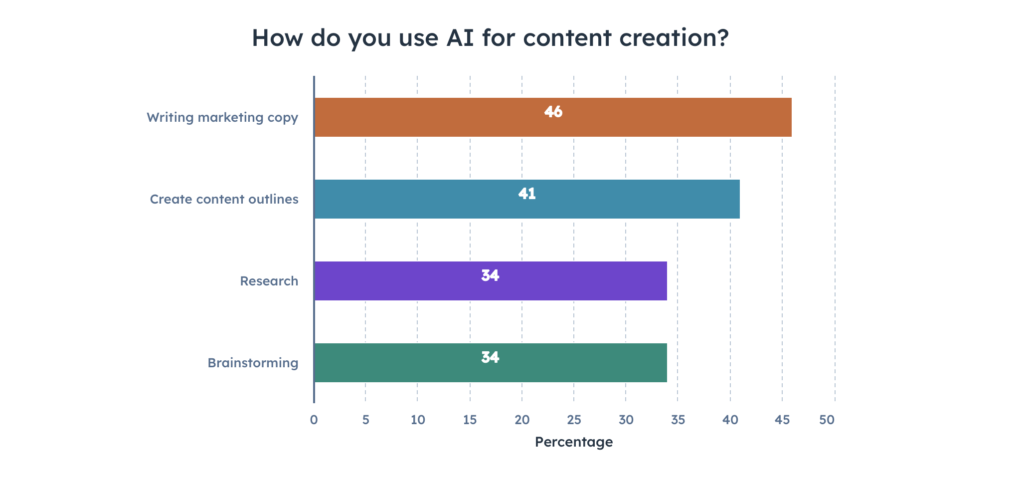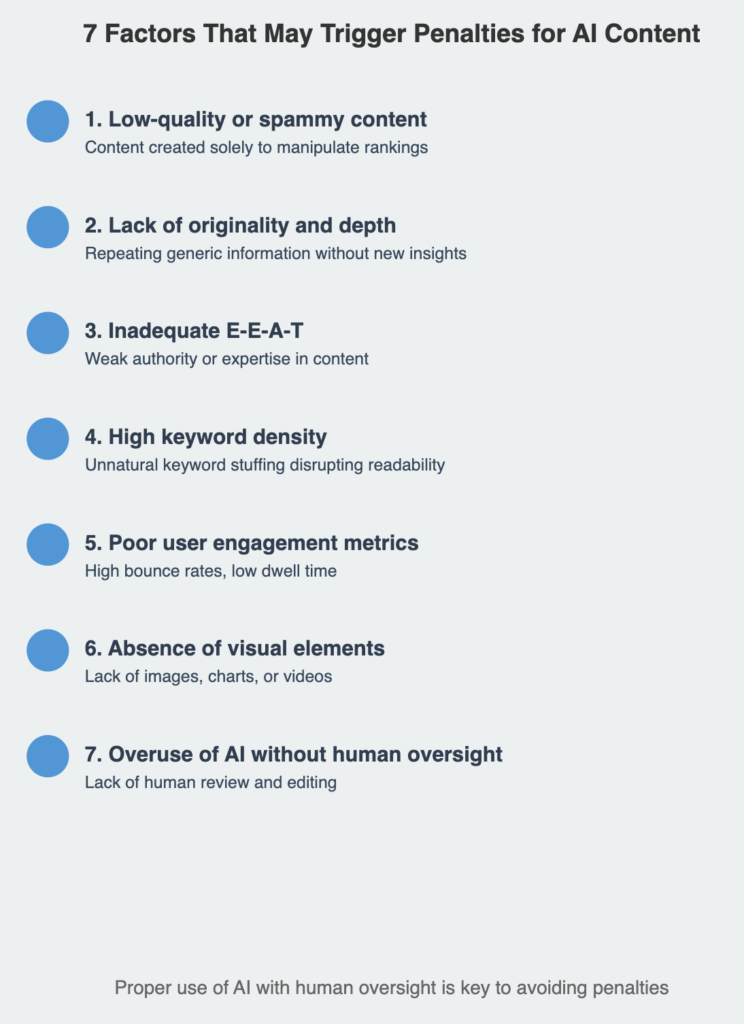The rise of artificial intelligence (AI) in content creation has been nothing short of revolutionary. Today, many content creators and businesses use AI to write articles, generating blog post outlines, social media captions, and even marketing emails.

While this technology has undoubtedly transformed how content is produced, it’s crucial to weigh its pros and cons carefully.
Using AI to write blog posts may seem like the ultimate solution for quick and efficient content creation. However, there are compelling reasons why relying solely on AI for blog posts might not be the best choice. This article explores the limitations and potential pitfalls of AI-generated content and provides insights on how to use it wisely.
When and Why Not to Use AI to Write Articles
Despite its capabilities, it is crucial to address why, AI might not be the ultimate solution for blog writing. This is not just about preserving traditional methods; it’s about maintaining the authenticity, creativity, and ethical integrity of content creation.
Let’s explore more.
1. Lack of Authenticity and Personal Voice
One of the most significant challenges when using AI to write blog posts is the lack of authenticity. AI-generated content often feels robotic, failing to capture the unique voice and personal touch that resonate with readers. Personal stories, anecdotes, and experiences add depth and relatability to blog posts—qualities AI struggles to replicate.
I’ve experienced this personally. This happened recently when I received an email from my co-league. He sent a well-put very descriptive email about a thing we discussed 10 minutes ago. When the Outlook chimed, I opened the email and thought how come this guy could research and write hundreds of words in an email within less than 10 minutes? I reckoned he put a simple query on ChatGPT and copy pasted the response to the email. Tell me honestly, would you trust such emails? Of course not.
The reason is marketing and communications remains deeply tied to human emotion and creativity. Readers connect with content that reflects genuine perspectives and unique insights. AI for blog posts may efficiently deliver data-driven narratives, but it cannot replicate the intuition and cultural nuance that human creators bring to their work.
2. Potential for Inaccuracies and Misinformation
Another concern is the risk of inaccuracies. AI tools rely on existing data to generate content, but this data may not always be accurate or up-to-date. Instances of AI producing factually incorrect or misleading information have been well-documented. And one of the mistakes content writers make is not verifying the content that AI produces.
AI is for everyone, but the skill to input and verifying the output is still the missing stone.
~ Madhukar Jangir
For example, an AI might pull outdated statistics or misinterpret context, resulting in misinformation. Imagine a scenario where an AI generates a blog post citing a population statistic from 2010 as current data, leading to misinformed decisions by readers. Similarly, it might misinterpret industry-specific jargon, producing content that appears authoritative but lacks true relevance or accuracy.
Content writers using AI to write blog posts must remain vigilant, ensuring that every output is fact-checked. While AI accelerates content production, the responsibility for accuracy lies squarely with human oversight. Effective collaboration between AI tools and skilled writers can minimize errors and protect brand credibility.
3. Ethical and Legal Considerations
Ethical concerns are another significant issue when using AI to write blog posts. Many AI tools generate content based on existing works, raising questions about plagiarism and intellectual property rights. Who truly owns the content generated by AI? These are questions many content creators grapple with.
Additionally, using AI for blog posts, you may inadvertently produce biased or culturally insensitive content due to the limitations of the data it has been trained on. As discussed by industry leaders, transparency about the use of AI is critical. Marketers and creators should disclose when AI is used and ensure that their content reflects ethical considerations and respects cultural sensitivities.
For instance, I’ve used AI as an assistant to write this article. But all the opinions are from my own experience as well as recent reports.
4. SEO and Search Engine Penalties
From an SEO perspective, relying on AI to write blog posts can be risky. Search engines like Google prioritize high-quality, original content that adds value to readers.
One thing to keep in mind here is that Google hasn’t yet clearly stated that AI-generated content is bad. In a recent February 2023 blog post, Google clarified that AI-generated content is acceptable as long as it aligns with its mission to prioritize quality, originality, and user satisfaction.
But, there are speculations among SEO communities that the search engine might roll-out algorithm updates in the future that can result in domain penalization. The general thought is that AI-generated content, especially when overused, can trigger penalties, reducing your website’s visibility and traffic.
Interestingly, experts suggest that AI for blog posts works best when it complements human efforts rather than replaces them. Marketers who strategically integrate AI to enhance content optimization for SEO, while retaining human creativity, are more likely to succeed in maintaining strong search rankings.
While we’re talking about SEO optimization, here are some things that’ll help you avoid Google penalties for AI content.

Also Read: Forget SEO – Here is How to Rank in AI Results
5. Over-reliance and Skill Degradation
Over time, relying solely on AI to write blog posts can lead to skill degradation among content creators. Writing is a craft that improves with practice. When creators use AI to write articles excessively, they may lose the ability to brainstorm, research, and craft compelling narratives independently.
Who am I kidding? In fact, I myself felt like loosing it a couple of year ago. I started using AI tools for content writing in 2020; way before ChatGPT was announced. I was using WriteSonic and it was great until I found out, I’m loosing my knack for long-form content writing. However, I’m in practice nowadays and write for fun just to keep the writer alive. But, you got the point I want to make here.
A human-centric approach to content creation ensures that marketers retain their adaptability and innovation. AI should enhance workflows, allowing creators to focus on strategic and creative tasks while leaving repetitive or data-driven elements to machines.
How Content Writers Can Use AI as an Assistant, Not a Replacement
It is clear that AI writers can’t replace human writers. While there are clear drawbacks, AI can be an excellent assistant in the content creation process. Here’s how content writers can use AI effectively, with detailed examples and actionable steps for each use case:
Brainstorming Ideas
AI tools like ChatGPT or Jasper can generate topic ideas and compelling headlines. For example, a content creator in the wellness niche could input “trending wellness topics” into an AI tool to receive suggestions such as “The Rise of Digital Detox Retreats” or “Top 10 Yoga Poses for Beginners.” These AI-generated ideas can spark inspiration and help writers refine their topics.
However, content writers should be mindful of using AI tools like ChatGPT to write blog posts. Each output that AI produces should be verified before publishing.
Outlining Content
AI can assist in organizing your ideas by generating structured outlines for articles. For instance, inputting “What is prompt engineering in content writing” into an AI tool might yield an outline that includes sections like prompt engineering techniques, how to write prompts, top blog post prompts, etc.
Actionable Tip: Review AI-generated outlines carefully, rearranging or expanding sections to align with your unique expertise and voice.
Creating Drafts
AI tools are capable of producing first drafts for blog posts.
For example, a content strategist might use AI to draft an article introducing the differences between TOFU and BOFU content types. The AI could generate a basic structure highlighting TOFU content as aimed at building awareness and BOFU content as focusing on conversions. While this initial draft provides a starting point, the strategist would refine it by adding practical examples, such as blog posts and case studies for BOFU, and social media posts or infographics for TOFU, ensuring the final piece resonates with the intended audience. While the draft serves as a starting point, the creator can refine the tone, style, and details to match their voice and ensure accuracy.
Actionable Tip: Use AI-generated drafts as a foundation. Focus on rewriting to infuse personal insights, correct inaccuracies, and add unique perspectives.
Optimizing for SEO, Readability, and Grammar
Using AI for blog posts can be valuable in identifying trending keywords, improving readability, and ensuring grammatical accuracy. By leveraging AI, content creators can identify key phrases that resonate with search intent and refine their writing for better clarity and audience engagement.
For example, a travel blogger creating content on “Best Places to Visit in 2024” might use AI to surface relevant keywords such as “travel trends,” “top destinations,” and “must-visit locations.” These keywords help improve the blog’s visibility on search engines, attracting more readers to the content. Simultaneously, AI-powered tools like Grammarly or Hemingway can ensure that the content is free of grammatical errors and maintains a clear, concise structure that appeals to readers.
Must Read: How to Improve Flesch and Kincaid Readability Score
However, while AI is effective at highlighting potential keywords, it’s crucial to validate these suggestions. AI may miss the nuances of your specific niche, such as regional search intent or seasonal relevance, which could impact the effectiveness of your SEO strategy.
Summarizing Research
Writers can use AI to condense lengthy reports or datasets into digestible summaries. For instance, if you’re writing an article on climate change, you can input a detailed scientific report into an AI tool to extract the key findings, saving time.
Actionable Tip: Always cross-check summaries with original sources to ensure accuracy and completeness. Use AI to manage time efficiently but maintain accountability for factual accuracy.
Industry insights emphasize that AI’s value lies in its ability to assist, not replace. Marketers who master the balance between AI and their own creativity will stand out in a competitive landscape.
Conclusion
AI to write blog posts is a powerful tool, but it should be approached with caution. While it can save time and streamline certain aspects of content creation, it cannot replace the authenticity, creativity, and critical thinking that human writers bring to the table.
By understanding its limitations and using AI as an assistant rather than a replacement, content creators can strike a balance that ensures their work remains engaging, accurate, and impactful. Industry leaders agree that human perspective is and will remain a cornerstone of great marketing content. Ultimately, successful content creation is a partnership between human ingenuity and technological innovation.

I’m a marketer turned into a content writer. I go the unconventional paths of content writing to explore the horizon of possibilities and novel approaches to help brands communicate.
If you’ve loved reading this blog, hit me a ‘Hi’ on LinkedIn.
